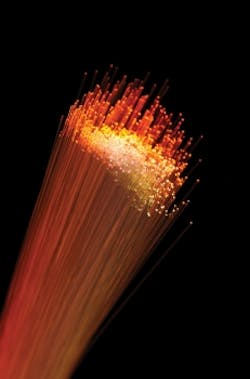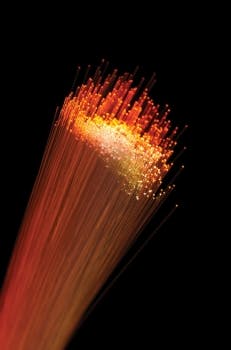Research points upward for fiber-optic markets
Formal market analyses and less-formal poll results suggest more fiber will be used in more places in the months and years ahead.
BY PATRICK MCLAUGHLIN
Late in 2010 multiple market researchers disclosed general findings of studies they had carried out on different segments of the fiber-optic cabling and networking markets. Those reports suggest the market has a healthy outlook in the months and years ahead. additionally, that formal research was backed up by some less-formal but perhaps no-less-telling polling conducted by the Fiber Optics LaN Section (FOLS; www.fols.org) of the Telecommunications Industry association (TIa; www.tiaonline.org).
In December Infonetics Research (www.infonetics.com) released a third-quarter market-share report as well as a forecast for enterprise routers and Ethernet switches, including both copper and fiber equipment. Matthias Machowinski, directing analyst for enterprise networking and video at Infonetics, summed up the situation as follows: "Despite the murky economic picture, 2010 is shaping up to be a great year for Ethernet switching, with sales for the year likely reaching the highest level ever at $18.5 billion, up 29 percent from 2009. also, we're finally seeing the enterprise router market come to life, driven by strong results in North america, China and Japan. Underinvestments in 2009 are taking a toll and driving sales to new heights."
Upbeat networking trends
Highlights of the report include a strong quarter for North america and the Europe-Middle East-africa (EMEa) regions, both of which showed quarter-over-quarter growth and strong year-over-year growth. Infonetics also reported that overall revenue-wise, Ethernet switches enjoyed their best-ever third quarter at $4.7 billion. The previous third-quarter high was $4.68 billion in 2008, immediately before the global economic downturn.
That report from Infonetics paints an overall positive picture for networking, including fiber-optic equipment as part of the mix. It follows a report from earlier in the year in which the researcher looked specifically at optical-based 10-, 40- and 100-Gbit networking ports in enterprise and carrier networks. Issued in May 2010, the report notes "unabated" uptake in networking gear at these speeds "even in the face of global economic difficulties, driven by unrelenting network traffic increases."
At the time that report was issued, Machowinski, its co-author, said, "Revenue from 10G port shipments to enterprises grew 32 percent in 2009, to $1.5 billion. Despite the significant pullback in overall investments in 2009-for example, Ethernet switch sales fell 19 percent in 2009-investments in high-speed networking devices increased as enterprises continued building out their core network infrastructure to respond to growing levels of traffic."
Michael Howard, principal analyst and co-founder of Infonetics, noted then, "While worldwide spending on service provider IP edge routers declined overall in 2009, spending on high-speed 40G ports on IP edge routers increased 125 percent. a similar trend is playing out in other routing and switching segments and in the optical network hardware space. This is the clearest indication yet that service providers are turning to higher-speed options for their next-generation networks to handle skyrocketing traffic."
In addition to looking at historical buying figures, Infonetics' 10G, 40G, 100G report from May 2010 also projected strong growth to continue. The researcher said combined 10-, 40- and 100-G port shipments will increase tenfold from 2009 to 2014.
Splicing and connectivity outlook
ElectroniCast Consultants (www.electronicastconsultants.com) also issued reports in 2010 that painted a rosy picture for fiber-optic markets. ElectroniCast's reports, however, focused more closely on specific hardware and tools used in fiber-optic network construction. In august it unveiled results of a study on fusion splicers and in December it came out with a forecast for fiber-optic connectors and mechanical splices.
The august report on fusion splicers was actually ElectroniCast's second such report of 2010; it also published analysis of the market in March 2010. "Since the March 2010 report," ElectroniCast said in august, "the industry is finding expanded and even new market opportunities." The firm's president of international business Stephen Montgomery said in august, "In terms of volume, the number of new fusion splicers put into action is on track for an increase of 12 percent versus 2009. also, as we reported in March 2010, the use of fusion splicers in the production [manufacturing] of fiber-optic components is showing stronger growth, on track for an increase of 16 percent versus the volume in 2009."
Montgomery also pointed to a specific type of splicer-handheld, rugged models-as gaining deployment. "More and more of the rugged smaller handheld splicers are finding their way into use," he said. "based on recent interviews of FTTx installation managers, there is increase in novice technicians in the last-mile installation arena and the clad-alignment splicer modules are increasingly popular.
"The crew chiefs increasingly are seeing the value of using the smaller rugged type of fusion splicers; however, the use of preterminated connector cable assemblies, as well as using field-installable connectors and/or mechanical splices is still strongly considered in many areas. also, a strong consideration to go with a more expensive grade of fusion splicer is often seen as mandatory."
Despite being an impediment to the use of fusion splicers, other fiber-termination methods are also on the rise and represent growing strength in the overall fiber-optic cabling marketplace. ElectroniCast's forecast for fiber-optic connector and mechanical splice markets issued in December 2010 cites a dramatic increase in bandwidth demand-beyond the limits of copper-as the primary driver of the markets for these connectivity products.
"Technological advances in fiber optics are assuring the migration of fiber closer and closer to the end user," the consultancy said when making the forecast available. "This translates into demand for shorter links where connectors represent a substantial share of the total installation cost. The cost concerns are being addressed with the introduction of smaller, lower-cost and easier-to-install connectors. Multifiber-connector [more than two fibers] use, still relatively small, will be the choice for high-density interconnect applications."
Poll reveals a look forward
A less formal, "show-of-hands"-type poll taken earlier in 2010 supports the notion that network users are opting for fiber-optic infrastructure and will continue to do so into the future. The TIa FOLS held a Web seminar in april 2010 entitled "Multimode fiber trends." In addition to reporting on general trends affecting the multimode fiber market, the FOLS polled its audience during the seminar. FOLS issued a report on the poll results; the report is available through the group's Web site. From that report: "FOLS attracts highly qualified people to its webinars, making the data we collect a useful snapshot of industry trends. The 214 viewers represented a wide range of industries and came from different types of jobs."
Poll questions posed during the Web seminar got between 29 and 42 responses. While it is not a scientific study, the poll does provide, as FOLS points out, a useful snapshot.
When asked what backbone data rate they anticipated running in 2015, 41 percent of poll respondents said 40 Gbits/sec. another 28 said 10 Gbits/sec, and 17 percent responded 100 Gbits/sec. In keeping with those responses, OM4 topped the list of responses to the question: What cabling media will you use to support rates in the backbone? Forty-six percent answered OM4, while OM3 netted 38 percent of responses. Singlemode fiber and OM2 fiber each garnered 8 percent of responses. Not too surprisingly, although copper was offered as a choice, not a single respondent to the poll conducted during the Web seminar on multimode fiber said they plan to use copper-based media as a backbone infrastructure.
Copper did make an appearance in response to a question about media choices in the horizontal. Category 6a was named by 31 percent of respondents and Category 6 named by 10 percent. However, Category 6a was outdone by OM3 fiber (named by 40 percent of respondents) and Category 6 fell short of OM4 (named by 14 percent) as horizontal-media choices.
Survey respondents will need such robust media in order to support the horizontal data rates they anticipate using by 2015. Nearly half-44 percent-said their networks' horizontal data rate will be 10 Gbits/sec. 1-Gbit/sec data was named as the next-highest percentage, 37 percent. and 15 percent said that by 2015 their horizontal data rate will be 40 Gbits/sec.
In December 2010, the FOLS produced another Web seminar, this one entitled "Ensuring 40/100G performance: Multimode fiber bandwidth testing and array solutions." a poll was conducted during that seminar as well, assessing trends similar to those explored earlier in the year. The FOLS is currently compiling the data from that poll. When completed, the information will be available at fols.org, as the information from the april 2010 poll is now.
PATRICK MCLAUGHLIN is chief editor of Cabling Installation & Maintenance.

